Integrative Leadership: A Comprehensive Analysis of Leadership Theory
VerifiedAdded on 2023/05/28
|12
|3571
|94
Essay
AI Summary
This essay provides an in-depth analysis of leadership theory, focusing on integrative leadership. It explores various leadership problems within organizations, such as failure to communicate, lack of clear vision, poor execution, and inability to provide feedback. The essay then delves into different leadership theories, including trait theory (openness, conscientiousness, extraversion, agreeableness, neuroticism), behavioral theory (task-oriented vs. relationship-oriented), contingency leadership, transformational leadership, and charismatic leadership. It also examines the concept of followership, highlighting the qualities of good followers and the differences between leadership and management. Finally, the essay incorporates lessons learned from a case study, emphasizing the interconnectedness of leaders and followers and the importance of visionary leadership in driving organizational success. Desklib offers a platform for students to access similar solved assignments and past papers.

Leadership theory
Integrative Leadership paper
Student Name
Integrative Leadership paper
Student Name
Paraphrase This Document
Need a fresh take? Get an instant paraphrase of this document with our AI Paraphraser
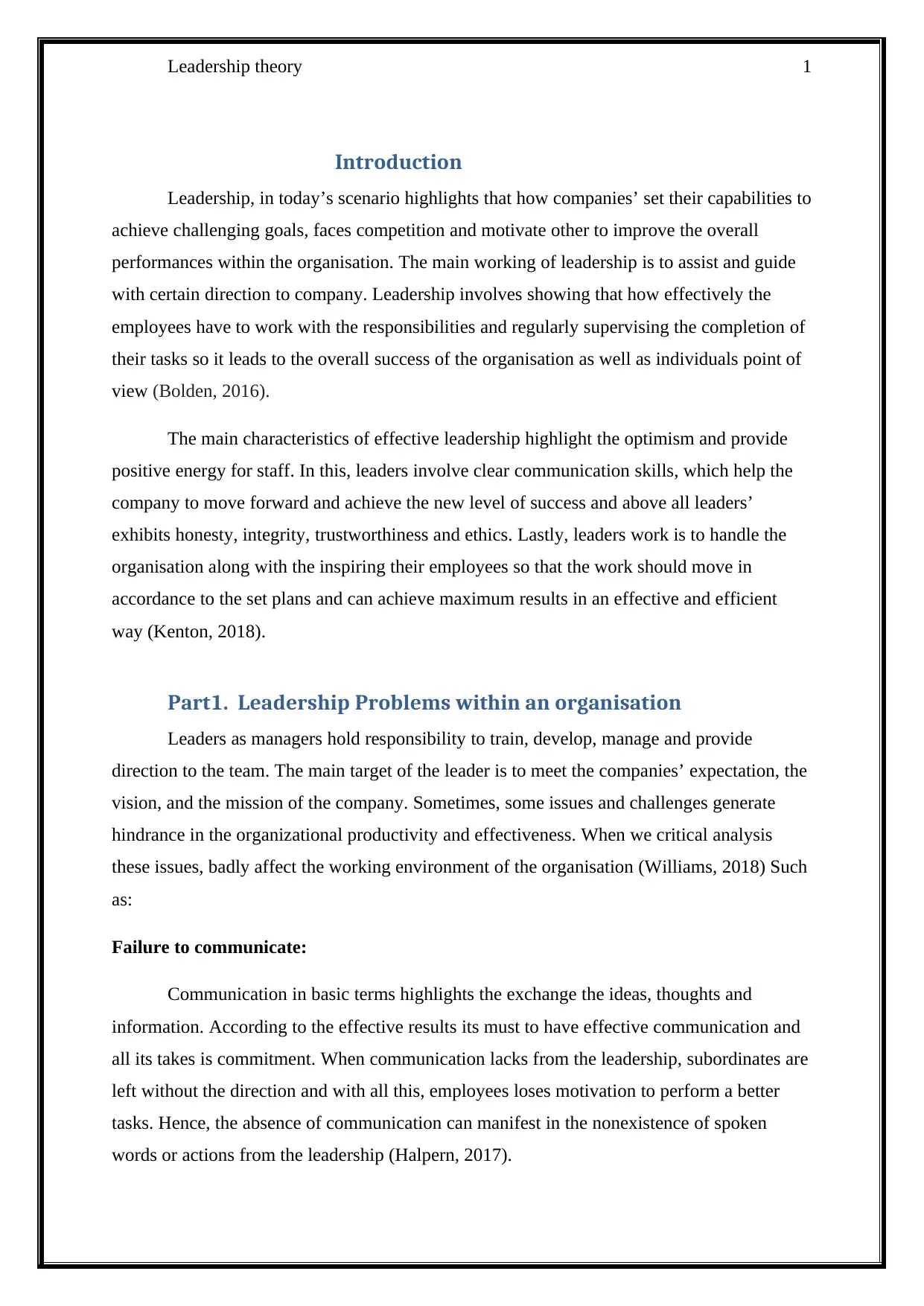
Leadership theory 1
Introduction
Leadership, in today’s scenario highlights that how companies’ set their capabilities to
achieve challenging goals, faces competition and motivate other to improve the overall
performances within the organisation. The main working of leadership is to assist and guide
with certain direction to company. Leadership involves showing that how effectively the
employees have to work with the responsibilities and regularly supervising the completion of
their tasks so it leads to the overall success of the organisation as well as individuals point of
view (Bolden, 2016).
The main characteristics of effective leadership highlight the optimism and provide
positive energy for staff. In this, leaders involve clear communication skills, which help the
company to move forward and achieve the new level of success and above all leaders’
exhibits honesty, integrity, trustworthiness and ethics. Lastly, leaders work is to handle the
organisation along with the inspiring their employees so that the work should move in
accordance to the set plans and can achieve maximum results in an effective and efficient
way (Kenton, 2018).
Part1. Leadership Problems within an organisation
Leaders as managers hold responsibility to train, develop, manage and provide
direction to the team. The main target of the leader is to meet the companies’ expectation, the
vision, and the mission of the company. Sometimes, some issues and challenges generate
hindrance in the organizational productivity and effectiveness. When we critical analysis
these issues, badly affect the working environment of the organisation (Williams, 2018) Such
as:
Failure to communicate:
Communication in basic terms highlights the exchange the ideas, thoughts and
information. According to the effective results its must to have effective communication and
all its takes is commitment. When communication lacks from the leadership, subordinates are
left without the direction and with all this, employees loses motivation to perform a better
tasks. Hence, the absence of communication can manifest in the nonexistence of spoken
words or actions from the leadership (Halpern, 2017).
Introduction
Leadership, in today’s scenario highlights that how companies’ set their capabilities to
achieve challenging goals, faces competition and motivate other to improve the overall
performances within the organisation. The main working of leadership is to assist and guide
with certain direction to company. Leadership involves showing that how effectively the
employees have to work with the responsibilities and regularly supervising the completion of
their tasks so it leads to the overall success of the organisation as well as individuals point of
view (Bolden, 2016).
The main characteristics of effective leadership highlight the optimism and provide
positive energy for staff. In this, leaders involve clear communication skills, which help the
company to move forward and achieve the new level of success and above all leaders’
exhibits honesty, integrity, trustworthiness and ethics. Lastly, leaders work is to handle the
organisation along with the inspiring their employees so that the work should move in
accordance to the set plans and can achieve maximum results in an effective and efficient
way (Kenton, 2018).
Part1. Leadership Problems within an organisation
Leaders as managers hold responsibility to train, develop, manage and provide
direction to the team. The main target of the leader is to meet the companies’ expectation, the
vision, and the mission of the company. Sometimes, some issues and challenges generate
hindrance in the organizational productivity and effectiveness. When we critical analysis
these issues, badly affect the working environment of the organisation (Williams, 2018) Such
as:
Failure to communicate:
Communication in basic terms highlights the exchange the ideas, thoughts and
information. According to the effective results its must to have effective communication and
all its takes is commitment. When communication lacks from the leadership, subordinates are
left without the direction and with all this, employees loses motivation to perform a better
tasks. Hence, the absence of communication can manifest in the nonexistence of spoken
words or actions from the leadership (Halpern, 2017).
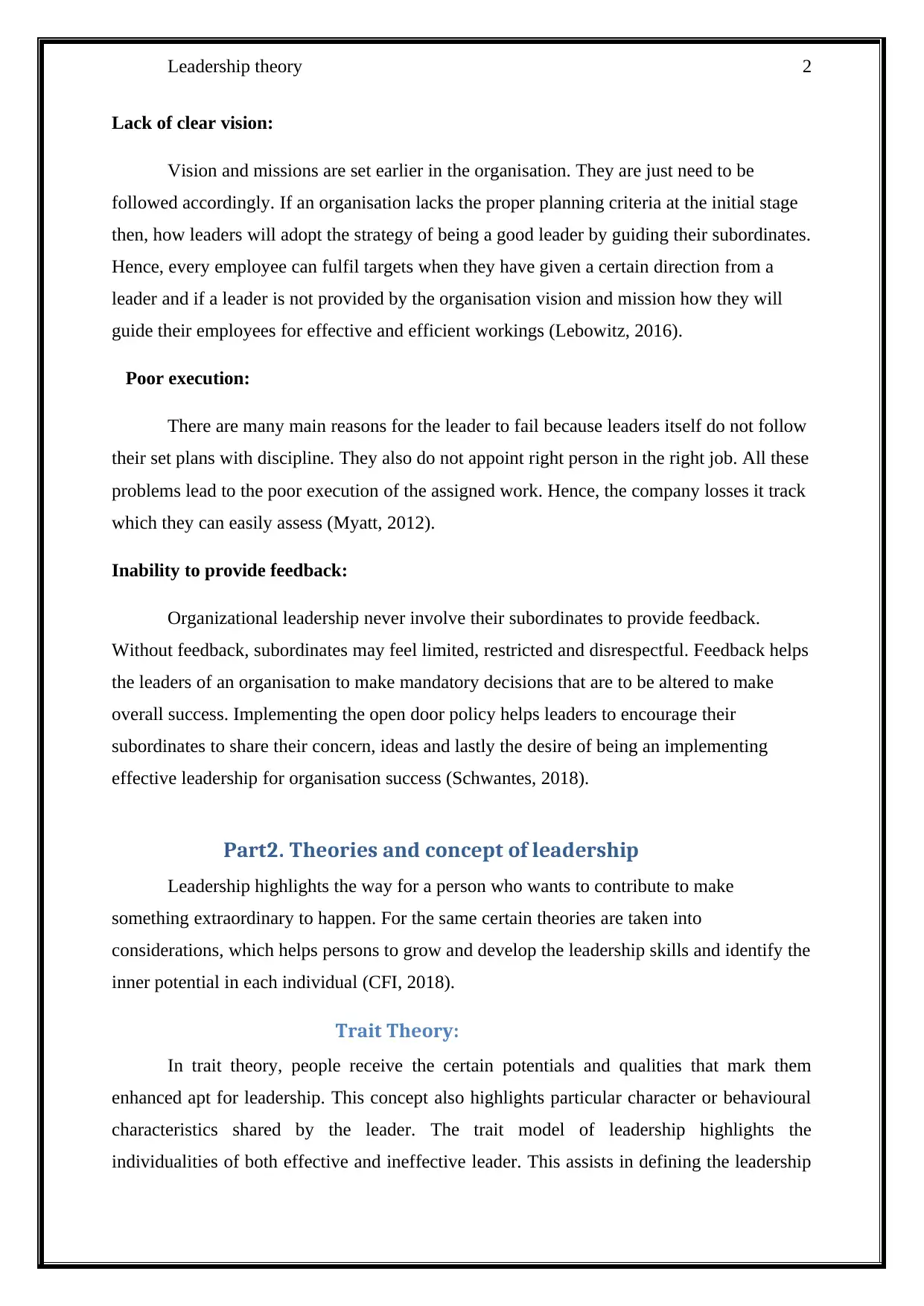
Leadership theory 2
Lack of clear vision:
Vision and missions are set earlier in the organisation. They are just need to be
followed accordingly. If an organisation lacks the proper planning criteria at the initial stage
then, how leaders will adopt the strategy of being a good leader by guiding their subordinates.
Hence, every employee can fulfil targets when they have given a certain direction from a
leader and if a leader is not provided by the organisation vision and mission how they will
guide their employees for effective and efficient workings (Lebowitz, 2016).
Poor execution:
There are many main reasons for the leader to fail because leaders itself do not follow
their set plans with discipline. They also do not appoint right person in the right job. All these
problems lead to the poor execution of the assigned work. Hence, the company losses it track
which they can easily assess (Myatt, 2012).
Inability to provide feedback:
Organizational leadership never involve their subordinates to provide feedback.
Without feedback, subordinates may feel limited, restricted and disrespectful. Feedback helps
the leaders of an organisation to make mandatory decisions that are to be altered to make
overall success. Implementing the open door policy helps leaders to encourage their
subordinates to share their concern, ideas and lastly the desire of being an implementing
effective leadership for organisation success (Schwantes, 2018).
Part2. Theories and concept of leadership
Leadership highlights the way for a person who wants to contribute to make
something extraordinary to happen. For the same certain theories are taken into
considerations, which helps persons to grow and develop the leadership skills and identify the
inner potential in each individual (CFI, 2018).
Trait Theory:
In trait theory, people receive the certain potentials and qualities that mark them
enhanced apt for leadership. This concept also highlights particular character or behavioural
characteristics shared by the leader. The trait model of leadership highlights the
individualities of both effective and ineffective leader. This assists in defining the leadership
Lack of clear vision:
Vision and missions are set earlier in the organisation. They are just need to be
followed accordingly. If an organisation lacks the proper planning criteria at the initial stage
then, how leaders will adopt the strategy of being a good leader by guiding their subordinates.
Hence, every employee can fulfil targets when they have given a certain direction from a
leader and if a leader is not provided by the organisation vision and mission how they will
guide their employees for effective and efficient workings (Lebowitz, 2016).
Poor execution:
There are many main reasons for the leader to fail because leaders itself do not follow
their set plans with discipline. They also do not appoint right person in the right job. All these
problems lead to the poor execution of the assigned work. Hence, the company losses it track
which they can easily assess (Myatt, 2012).
Inability to provide feedback:
Organizational leadership never involve their subordinates to provide feedback.
Without feedback, subordinates may feel limited, restricted and disrespectful. Feedback helps
the leaders of an organisation to make mandatory decisions that are to be altered to make
overall success. Implementing the open door policy helps leaders to encourage their
subordinates to share their concern, ideas and lastly the desire of being an implementing
effective leadership for organisation success (Schwantes, 2018).
Part2. Theories and concept of leadership
Leadership highlights the way for a person who wants to contribute to make
something extraordinary to happen. For the same certain theories are taken into
considerations, which helps persons to grow and develop the leadership skills and identify the
inner potential in each individual (CFI, 2018).
Trait Theory:
In trait theory, people receive the certain potentials and qualities that mark them
enhanced apt for leadership. This concept also highlights particular character or behavioural
characteristics shared by the leader. The trait model of leadership highlights the
individualities of both effective and ineffective leader. This assists in defining the leadership
⊘ This is a preview!⊘
Do you want full access?
Subscribe today to unlock all pages.

Trusted by 1+ million students worldwide
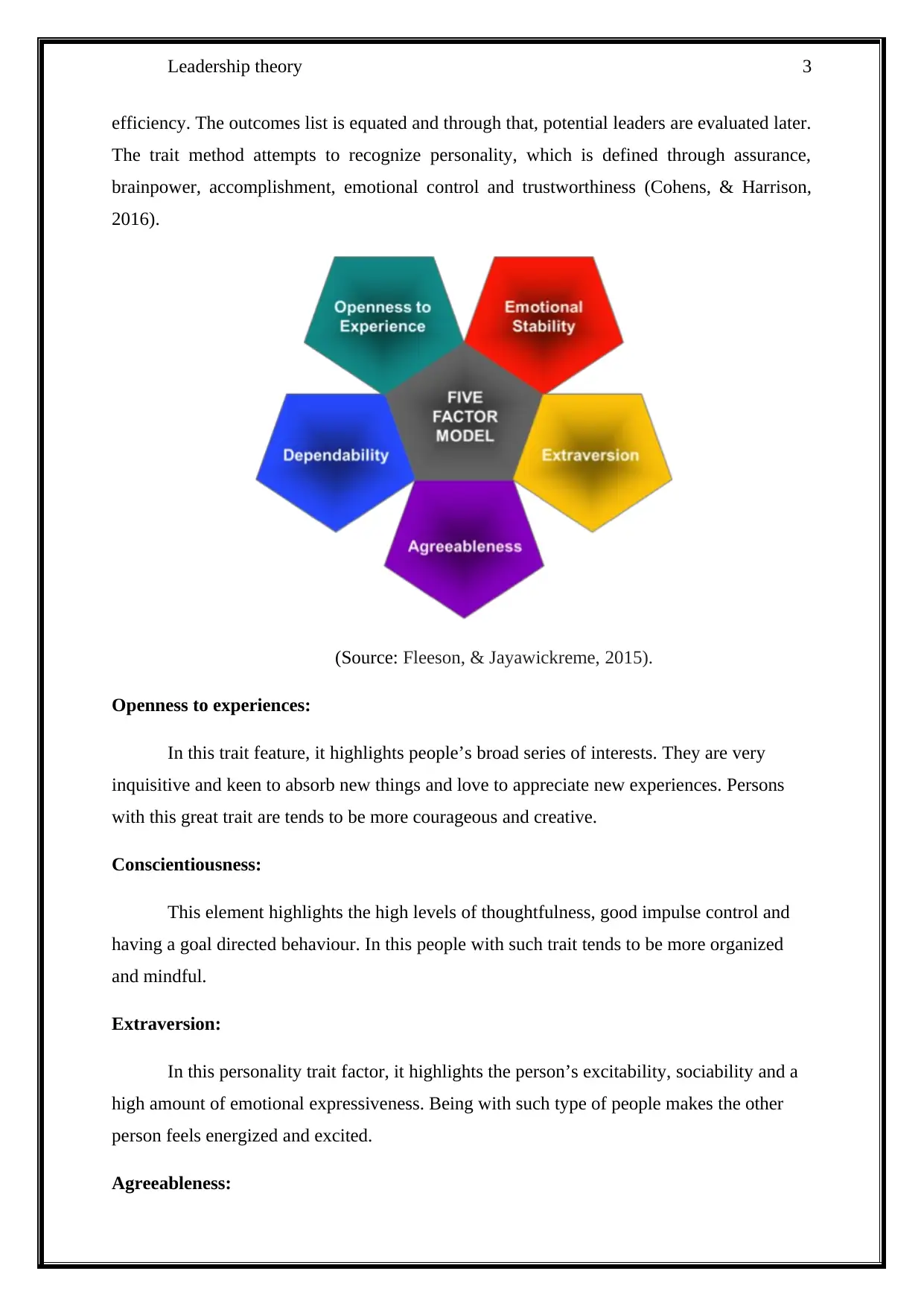
Leadership theory 3
efficiency. The outcomes list is equated and through that, potential leaders are evaluated later.
The trait method attempts to recognize personality, which is defined through assurance,
brainpower, accomplishment, emotional control and trustworthiness (Cohens, & Harrison,
2016).
(Source: Fleeson, & Jayawickreme, 2015).
Openness to experiences:
In this trait feature, it highlights people’s broad series of interests. They are very
inquisitive and keen to absorb new things and love to appreciate new experiences. Persons
with this great trait are tends to be more courageous and creative.
Conscientiousness:
This element highlights the high levels of thoughtfulness, good impulse control and
having a goal directed behaviour. In this people with such trait tends to be more organized
and mindful.
Extraversion:
In this personality trait factor, it highlights the person’s excitability, sociability and a
high amount of emotional expressiveness. Being with such type of people makes the other
person feels energized and excited.
Agreeableness:
efficiency. The outcomes list is equated and through that, potential leaders are evaluated later.
The trait method attempts to recognize personality, which is defined through assurance,
brainpower, accomplishment, emotional control and trustworthiness (Cohens, & Harrison,
2016).
(Source: Fleeson, & Jayawickreme, 2015).
Openness to experiences:
In this trait feature, it highlights people’s broad series of interests. They are very
inquisitive and keen to absorb new things and love to appreciate new experiences. Persons
with this great trait are tends to be more courageous and creative.
Conscientiousness:
This element highlights the high levels of thoughtfulness, good impulse control and
having a goal directed behaviour. In this people with such trait tends to be more organized
and mindful.
Extraversion:
In this personality trait factor, it highlights the person’s excitability, sociability and a
high amount of emotional expressiveness. Being with such type of people makes the other
person feels energized and excited.
Agreeableness:
Paraphrase This Document
Need a fresh take? Get an instant paraphrase of this document with our AI Paraphraser
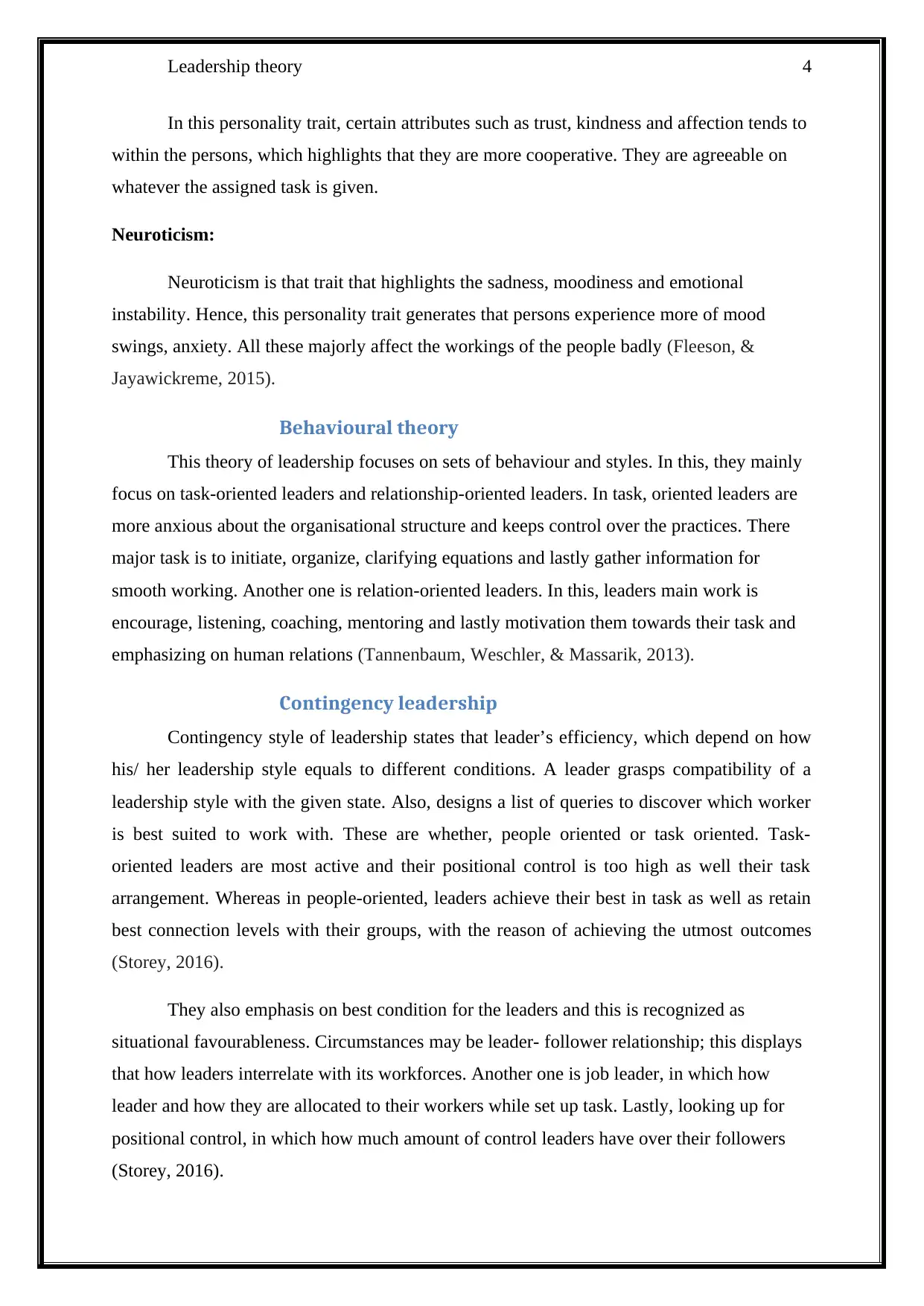
Leadership theory 4
In this personality trait, certain attributes such as trust, kindness and affection tends to
within the persons, which highlights that they are more cooperative. They are agreeable on
whatever the assigned task is given.
Neuroticism:
Neuroticism is that trait that highlights the sadness, moodiness and emotional
instability. Hence, this personality trait generates that persons experience more of mood
swings, anxiety. All these majorly affect the workings of the people badly (Fleeson, &
Jayawickreme, 2015).
Behavioural theory
This theory of leadership focuses on sets of behaviour and styles. In this, they mainly
focus on task-oriented leaders and relationship-oriented leaders. In task, oriented leaders are
more anxious about the organisational structure and keeps control over the practices. There
major task is to initiate, organize, clarifying equations and lastly gather information for
smooth working. Another one is relation-oriented leaders. In this, leaders main work is
encourage, listening, coaching, mentoring and lastly motivation them towards their task and
emphasizing on human relations (Tannenbaum, Weschler, & Massarik, 2013).
Contingency leadership
Contingency style of leadership states that leader’s efficiency, which depend on how
his/ her leadership style equals to different conditions. A leader grasps compatibility of a
leadership style with the given state. Also, designs a list of queries to discover which worker
is best suited to work with. These are whether, people oriented or task oriented. Task-
oriented leaders are most active and their positional control is too high as well their task
arrangement. Whereas in people-oriented, leaders achieve their best in task as well as retain
best connection levels with their groups, with the reason of achieving the utmost outcomes
(Storey, 2016).
They also emphasis on best condition for the leaders and this is recognized as
situational favourableness. Circumstances may be leader- follower relationship; this displays
that how leaders interrelate with its workforces. Another one is job leader, in which how
leader and how they are allocated to their workers while set up task. Lastly, looking up for
positional control, in which how much amount of control leaders have over their followers
(Storey, 2016).
In this personality trait, certain attributes such as trust, kindness and affection tends to
within the persons, which highlights that they are more cooperative. They are agreeable on
whatever the assigned task is given.
Neuroticism:
Neuroticism is that trait that highlights the sadness, moodiness and emotional
instability. Hence, this personality trait generates that persons experience more of mood
swings, anxiety. All these majorly affect the workings of the people badly (Fleeson, &
Jayawickreme, 2015).
Behavioural theory
This theory of leadership focuses on sets of behaviour and styles. In this, they mainly
focus on task-oriented leaders and relationship-oriented leaders. In task, oriented leaders are
more anxious about the organisational structure and keeps control over the practices. There
major task is to initiate, organize, clarifying equations and lastly gather information for
smooth working. Another one is relation-oriented leaders. In this, leaders main work is
encourage, listening, coaching, mentoring and lastly motivation them towards their task and
emphasizing on human relations (Tannenbaum, Weschler, & Massarik, 2013).
Contingency leadership
Contingency style of leadership states that leader’s efficiency, which depend on how
his/ her leadership style equals to different conditions. A leader grasps compatibility of a
leadership style with the given state. Also, designs a list of queries to discover which worker
is best suited to work with. These are whether, people oriented or task oriented. Task-
oriented leaders are most active and their positional control is too high as well their task
arrangement. Whereas in people-oriented, leaders achieve their best in task as well as retain
best connection levels with their groups, with the reason of achieving the utmost outcomes
(Storey, 2016).
They also emphasis on best condition for the leaders and this is recognized as
situational favourableness. Circumstances may be leader- follower relationship; this displays
that how leaders interrelate with its workforces. Another one is job leader, in which how
leader and how they are allocated to their workers while set up task. Lastly, looking up for
positional control, in which how much amount of control leaders have over their followers
(Storey, 2016).
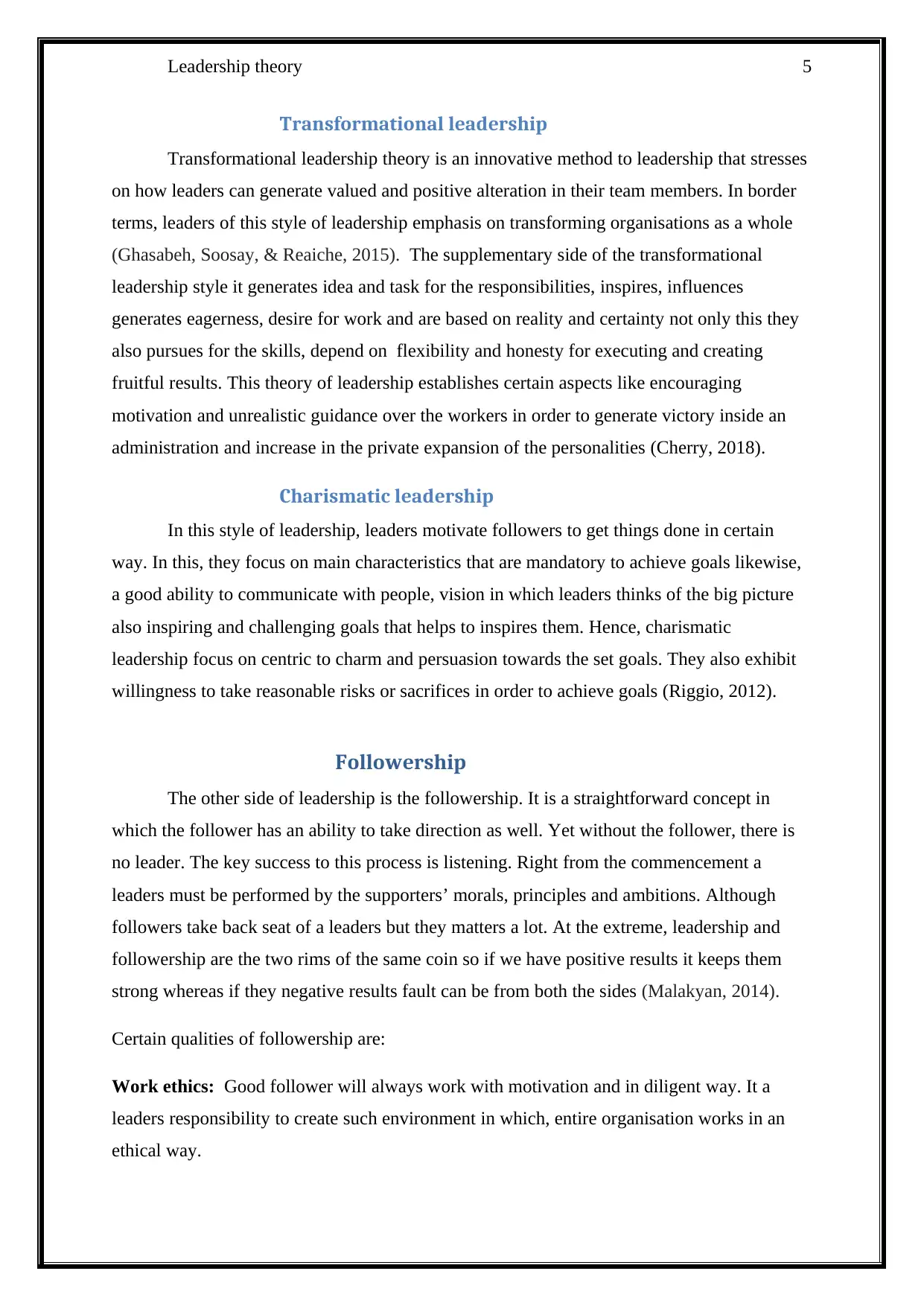
Leadership theory 5
Transformational leadership
Transformational leadership theory is an innovative method to leadership that stresses
on how leaders can generate valued and positive alteration in their team members. In border
terms, leaders of this style of leadership emphasis on transforming organisations as a whole
(Ghasabeh, Soosay, & Reaiche, 2015). The supplementary side of the transformational
leadership style it generates idea and task for the responsibilities, inspires, influences
generates eagerness, desire for work and are based on reality and certainty not only this they
also pursues for the skills, depend on flexibility and honesty for executing and creating
fruitful results. This theory of leadership establishes certain aspects like encouraging
motivation and unrealistic guidance over the workers in order to generate victory inside an
administration and increase in the private expansion of the personalities (Cherry, 2018).
Charismatic leadership
In this style of leadership, leaders motivate followers to get things done in certain
way. In this, they focus on main characteristics that are mandatory to achieve goals likewise,
a good ability to communicate with people, vision in which leaders thinks of the big picture
also inspiring and challenging goals that helps to inspires them. Hence, charismatic
leadership focus on centric to charm and persuasion towards the set goals. They also exhibit
willingness to take reasonable risks or sacrifices in order to achieve goals (Riggio, 2012).
Followership
The other side of leadership is the followership. It is a straightforward concept in
which the follower has an ability to take direction as well. Yet without the follower, there is
no leader. The key success to this process is listening. Right from the commencement a
leaders must be performed by the supporters’ morals, principles and ambitions. Although
followers take back seat of a leaders but they matters a lot. At the extreme, leadership and
followership are the two rims of the same coin so if we have positive results it keeps them
strong whereas if they negative results fault can be from both the sides (Malakyan, 2014).
Certain qualities of followership are:
Work ethics: Good follower will always work with motivation and in diligent way. It a
leaders responsibility to create such environment in which, entire organisation works in an
ethical way.
Transformational leadership
Transformational leadership theory is an innovative method to leadership that stresses
on how leaders can generate valued and positive alteration in their team members. In border
terms, leaders of this style of leadership emphasis on transforming organisations as a whole
(Ghasabeh, Soosay, & Reaiche, 2015). The supplementary side of the transformational
leadership style it generates idea and task for the responsibilities, inspires, influences
generates eagerness, desire for work and are based on reality and certainty not only this they
also pursues for the skills, depend on flexibility and honesty for executing and creating
fruitful results. This theory of leadership establishes certain aspects like encouraging
motivation and unrealistic guidance over the workers in order to generate victory inside an
administration and increase in the private expansion of the personalities (Cherry, 2018).
Charismatic leadership
In this style of leadership, leaders motivate followers to get things done in certain
way. In this, they focus on main characteristics that are mandatory to achieve goals likewise,
a good ability to communicate with people, vision in which leaders thinks of the big picture
also inspiring and challenging goals that helps to inspires them. Hence, charismatic
leadership focus on centric to charm and persuasion towards the set goals. They also exhibit
willingness to take reasonable risks or sacrifices in order to achieve goals (Riggio, 2012).
Followership
The other side of leadership is the followership. It is a straightforward concept in
which the follower has an ability to take direction as well. Yet without the follower, there is
no leader. The key success to this process is listening. Right from the commencement a
leaders must be performed by the supporters’ morals, principles and ambitions. Although
followers take back seat of a leaders but they matters a lot. At the extreme, leadership and
followership are the two rims of the same coin so if we have positive results it keeps them
strong whereas if they negative results fault can be from both the sides (Malakyan, 2014).
Certain qualities of followership are:
Work ethics: Good follower will always work with motivation and in diligent way. It a
leaders responsibility to create such environment in which, entire organisation works in an
ethical way.
⊘ This is a preview!⊘
Do you want full access?
Subscribe today to unlock all pages.

Trusted by 1+ million students worldwide
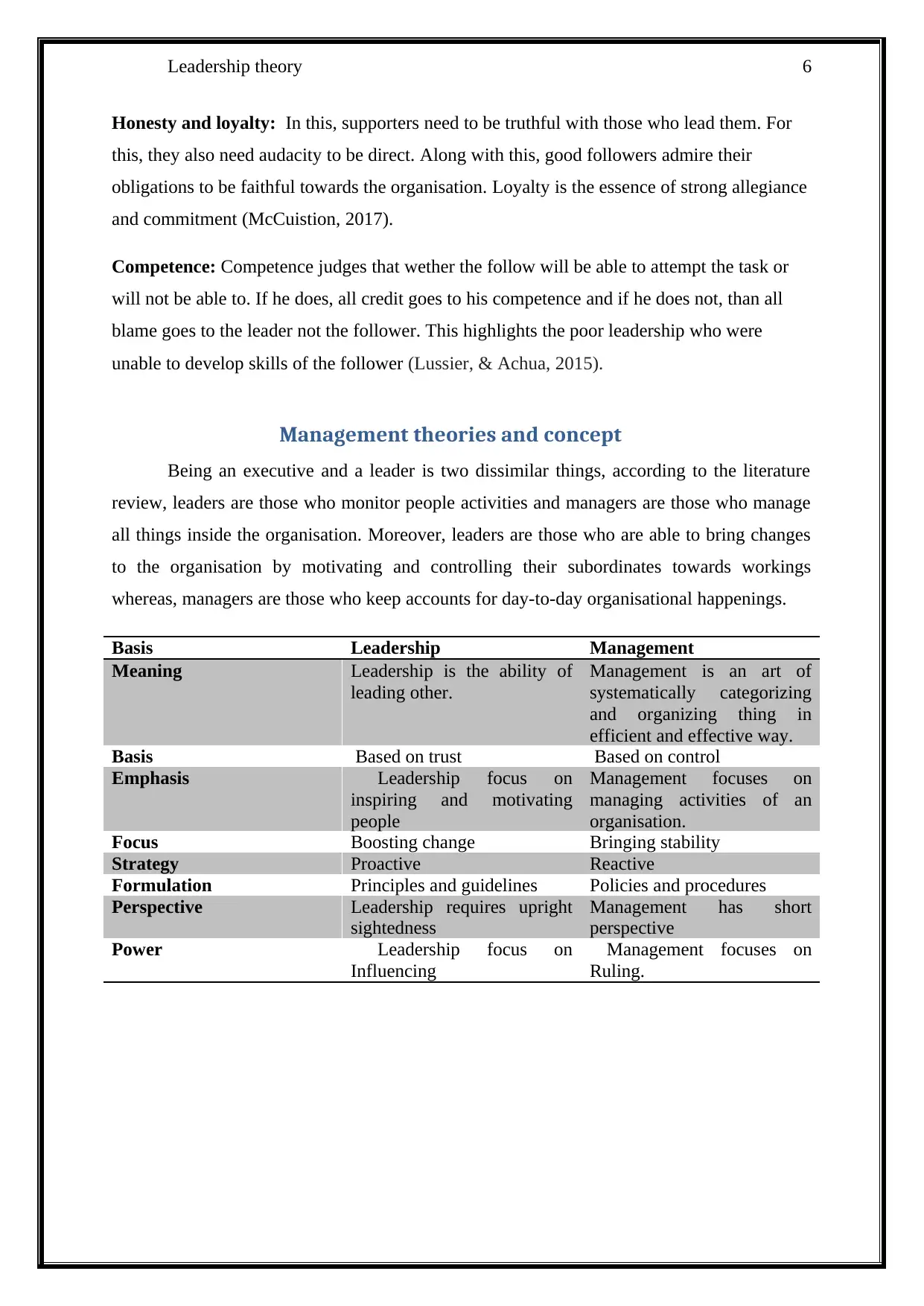
Leadership theory 6
Honesty and loyalty: In this, supporters need to be truthful with those who lead them. For
this, they also need audacity to be direct. Along with this, good followers admire their
obligations to be faithful towards the organisation. Loyalty is the essence of strong allegiance
and commitment (McCuistion, 2017).
Competence: Competence judges that wether the follow will be able to attempt the task or
will not be able to. If he does, all credit goes to his competence and if he does not, than all
blame goes to the leader not the follower. This highlights the poor leadership who were
unable to develop skills of the follower (Lussier, & Achua, 2015).
Management theories and concept
Being an executive and a leader is two dissimilar things, according to the literature
review, leaders are those who monitor people activities and managers are those who manage
all things inside the organisation. Moreover, leaders are those who are able to bring changes
to the organisation by motivating and controlling their subordinates towards workings
whereas, managers are those who keep accounts for day-to-day organisational happenings.
Basis Leadership Management
Meaning Leadership is the ability of
leading other.
Management is an art of
systematically categorizing
and organizing thing in
efficient and effective way.
Basis Based on trust Based on control
Emphasis Leadership focus on
inspiring and motivating
people
Management focuses on
managing activities of an
organisation.
Focus Boosting change Bringing stability
Strategy Proactive Reactive
Formulation Principles and guidelines Policies and procedures
Perspective Leadership requires upright
sightedness
Management has short
perspective
Power Leadership focus on
Influencing
Management focuses on
Ruling.
Honesty and loyalty: In this, supporters need to be truthful with those who lead them. For
this, they also need audacity to be direct. Along with this, good followers admire their
obligations to be faithful towards the organisation. Loyalty is the essence of strong allegiance
and commitment (McCuistion, 2017).
Competence: Competence judges that wether the follow will be able to attempt the task or
will not be able to. If he does, all credit goes to his competence and if he does not, than all
blame goes to the leader not the follower. This highlights the poor leadership who were
unable to develop skills of the follower (Lussier, & Achua, 2015).
Management theories and concept
Being an executive and a leader is two dissimilar things, according to the literature
review, leaders are those who monitor people activities and managers are those who manage
all things inside the organisation. Moreover, leaders are those who are able to bring changes
to the organisation by motivating and controlling their subordinates towards workings
whereas, managers are those who keep accounts for day-to-day organisational happenings.
Basis Leadership Management
Meaning Leadership is the ability of
leading other.
Management is an art of
systematically categorizing
and organizing thing in
efficient and effective way.
Basis Based on trust Based on control
Emphasis Leadership focus on
inspiring and motivating
people
Management focuses on
managing activities of an
organisation.
Focus Boosting change Bringing stability
Strategy Proactive Reactive
Formulation Principles and guidelines Policies and procedures
Perspective Leadership requires upright
sightedness
Management has short
perspective
Power Leadership focus on
Influencing
Management focuses on
Ruling.
Paraphrase This Document
Need a fresh take? Get an instant paraphrase of this document with our AI Paraphraser
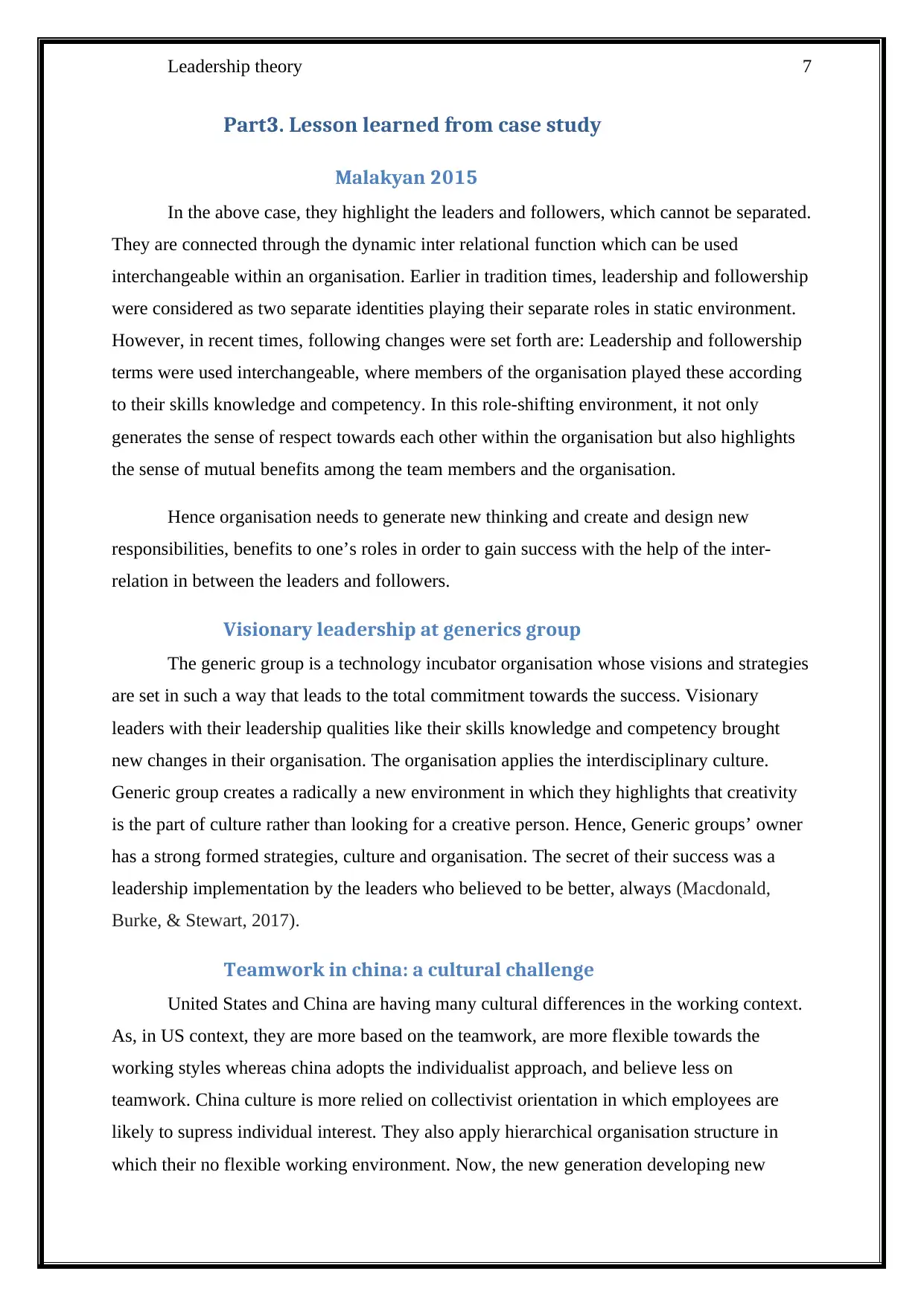
Leadership theory 7
Part3. Lesson learned from case study
Malakyan 2015
In the above case, they highlight the leaders and followers, which cannot be separated.
They are connected through the dynamic inter relational function which can be used
interchangeable within an organisation. Earlier in tradition times, leadership and followership
were considered as two separate identities playing their separate roles in static environment.
However, in recent times, following changes were set forth are: Leadership and followership
terms were used interchangeable, where members of the organisation played these according
to their skills knowledge and competency. In this role-shifting environment, it not only
generates the sense of respect towards each other within the organisation but also highlights
the sense of mutual benefits among the team members and the organisation.
Hence organisation needs to generate new thinking and create and design new
responsibilities, benefits to one’s roles in order to gain success with the help of the inter-
relation in between the leaders and followers.
Visionary leadership at generics group
The generic group is a technology incubator organisation whose visions and strategies
are set in such a way that leads to the total commitment towards the success. Visionary
leaders with their leadership qualities like their skills knowledge and competency brought
new changes in their organisation. The organisation applies the interdisciplinary culture.
Generic group creates a radically a new environment in which they highlights that creativity
is the part of culture rather than looking for a creative person. Hence, Generic groups’ owner
has a strong formed strategies, culture and organisation. The secret of their success was a
leadership implementation by the leaders who believed to be better, always (Macdonald,
Burke, & Stewart, 2017).
Teamwork in china: a cultural challenge
United States and China are having many cultural differences in the working context.
As, in US context, they are more based on the teamwork, are more flexible towards the
working styles whereas china adopts the individualist approach, and believe less on
teamwork. China culture is more relied on collectivist orientation in which employees are
likely to supress individual interest. They also apply hierarchical organisation structure in
which their no flexible working environment. Now, the new generation developing new
Part3. Lesson learned from case study
Malakyan 2015
In the above case, they highlight the leaders and followers, which cannot be separated.
They are connected through the dynamic inter relational function which can be used
interchangeable within an organisation. Earlier in tradition times, leadership and followership
were considered as two separate identities playing their separate roles in static environment.
However, in recent times, following changes were set forth are: Leadership and followership
terms were used interchangeable, where members of the organisation played these according
to their skills knowledge and competency. In this role-shifting environment, it not only
generates the sense of respect towards each other within the organisation but also highlights
the sense of mutual benefits among the team members and the organisation.
Hence organisation needs to generate new thinking and create and design new
responsibilities, benefits to one’s roles in order to gain success with the help of the inter-
relation in between the leaders and followers.
Visionary leadership at generics group
The generic group is a technology incubator organisation whose visions and strategies
are set in such a way that leads to the total commitment towards the success. Visionary
leaders with their leadership qualities like their skills knowledge and competency brought
new changes in their organisation. The organisation applies the interdisciplinary culture.
Generic group creates a radically a new environment in which they highlights that creativity
is the part of culture rather than looking for a creative person. Hence, Generic groups’ owner
has a strong formed strategies, culture and organisation. The secret of their success was a
leadership implementation by the leaders who believed to be better, always (Macdonald,
Burke, & Stewart, 2017).
Teamwork in china: a cultural challenge
United States and China are having many cultural differences in the working context.
As, in US context, they are more based on the teamwork, are more flexible towards the
working styles whereas china adopts the individualist approach, and believe less on
teamwork. China culture is more relied on collectivist orientation in which employees are
likely to supress individual interest. They also apply hierarchical organisation structure in
which their no flexible working environment. Now, the new generation developing new
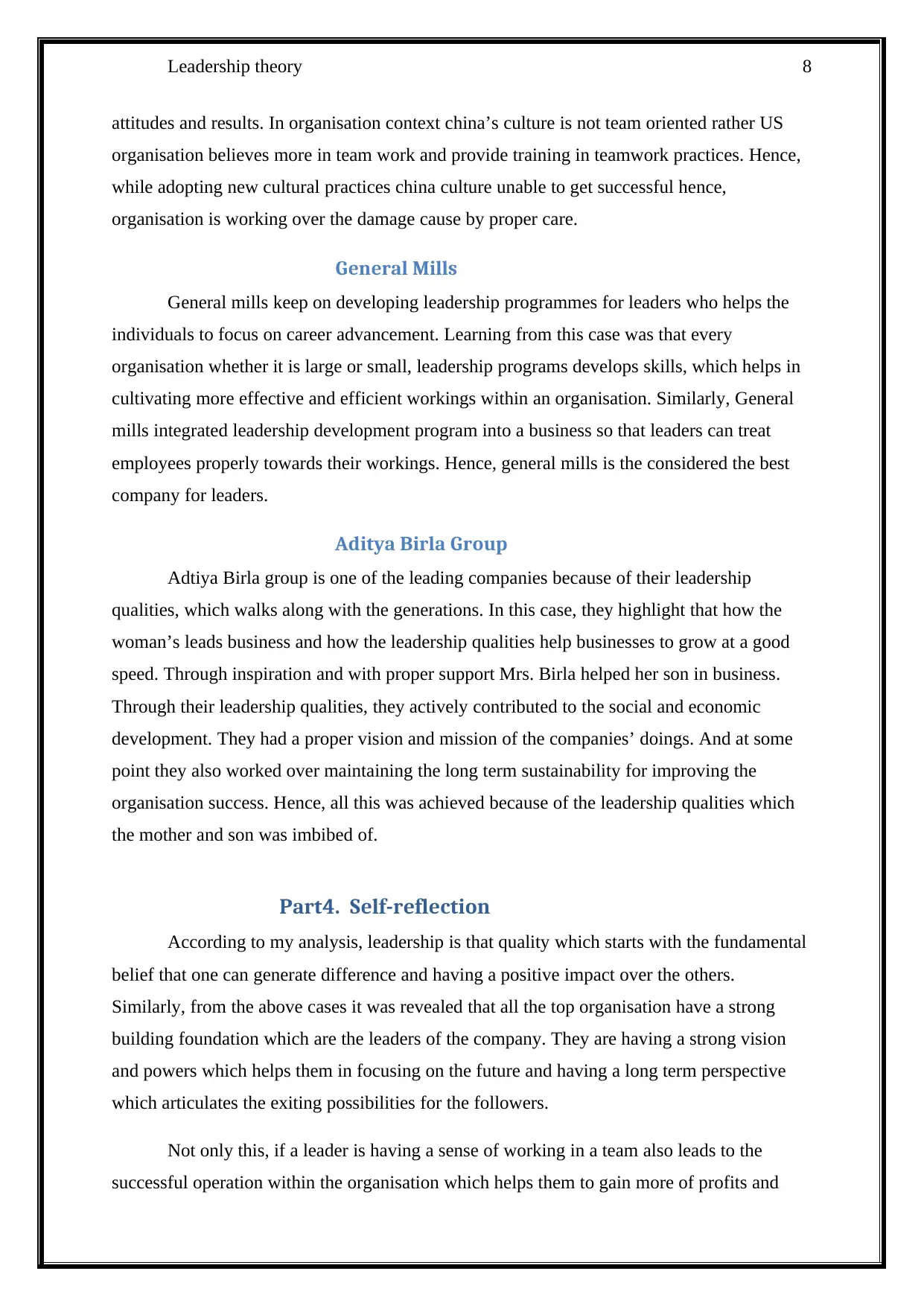
Leadership theory 8
attitudes and results. In organisation context china’s culture is not team oriented rather US
organisation believes more in team work and provide training in teamwork practices. Hence,
while adopting new cultural practices china culture unable to get successful hence,
organisation is working over the damage cause by proper care.
General Mills
General mills keep on developing leadership programmes for leaders who helps the
individuals to focus on career advancement. Learning from this case was that every
organisation whether it is large or small, leadership programs develops skills, which helps in
cultivating more effective and efficient workings within an organisation. Similarly, General
mills integrated leadership development program into a business so that leaders can treat
employees properly towards their workings. Hence, general mills is the considered the best
company for leaders.
Aditya Birla Group
Adtiya Birla group is one of the leading companies because of their leadership
qualities, which walks along with the generations. In this case, they highlight that how the
woman’s leads business and how the leadership qualities help businesses to grow at a good
speed. Through inspiration and with proper support Mrs. Birla helped her son in business.
Through their leadership qualities, they actively contributed to the social and economic
development. They had a proper vision and mission of the companies’ doings. And at some
point they also worked over maintaining the long term sustainability for improving the
organisation success. Hence, all this was achieved because of the leadership qualities which
the mother and son was imbibed of.
Part4. Self-reflection
According to my analysis, leadership is that quality which starts with the fundamental
belief that one can generate difference and having a positive impact over the others.
Similarly, from the above cases it was revealed that all the top organisation have a strong
building foundation which are the leaders of the company. They are having a strong vision
and powers which helps them in focusing on the future and having a long term perspective
which articulates the exiting possibilities for the followers.
Not only this, if a leader is having a sense of working in a team also leads to the
successful operation within the organisation which helps them to gain more of profits and
attitudes and results. In organisation context china’s culture is not team oriented rather US
organisation believes more in team work and provide training in teamwork practices. Hence,
while adopting new cultural practices china culture unable to get successful hence,
organisation is working over the damage cause by proper care.
General Mills
General mills keep on developing leadership programmes for leaders who helps the
individuals to focus on career advancement. Learning from this case was that every
organisation whether it is large or small, leadership programs develops skills, which helps in
cultivating more effective and efficient workings within an organisation. Similarly, General
mills integrated leadership development program into a business so that leaders can treat
employees properly towards their workings. Hence, general mills is the considered the best
company for leaders.
Aditya Birla Group
Adtiya Birla group is one of the leading companies because of their leadership
qualities, which walks along with the generations. In this case, they highlight that how the
woman’s leads business and how the leadership qualities help businesses to grow at a good
speed. Through inspiration and with proper support Mrs. Birla helped her son in business.
Through their leadership qualities, they actively contributed to the social and economic
development. They had a proper vision and mission of the companies’ doings. And at some
point they also worked over maintaining the long term sustainability for improving the
organisation success. Hence, all this was achieved because of the leadership qualities which
the mother and son was imbibed of.
Part4. Self-reflection
According to my analysis, leadership is that quality which starts with the fundamental
belief that one can generate difference and having a positive impact over the others.
Similarly, from the above cases it was revealed that all the top organisation have a strong
building foundation which are the leaders of the company. They are having a strong vision
and powers which helps them in focusing on the future and having a long term perspective
which articulates the exiting possibilities for the followers.
Not only this, if a leader is having a sense of working in a team also leads to the
successful operation within the organisation which helps them to gain more of profits and
⊘ This is a preview!⊘
Do you want full access?
Subscribe today to unlock all pages.

Trusted by 1+ million students worldwide
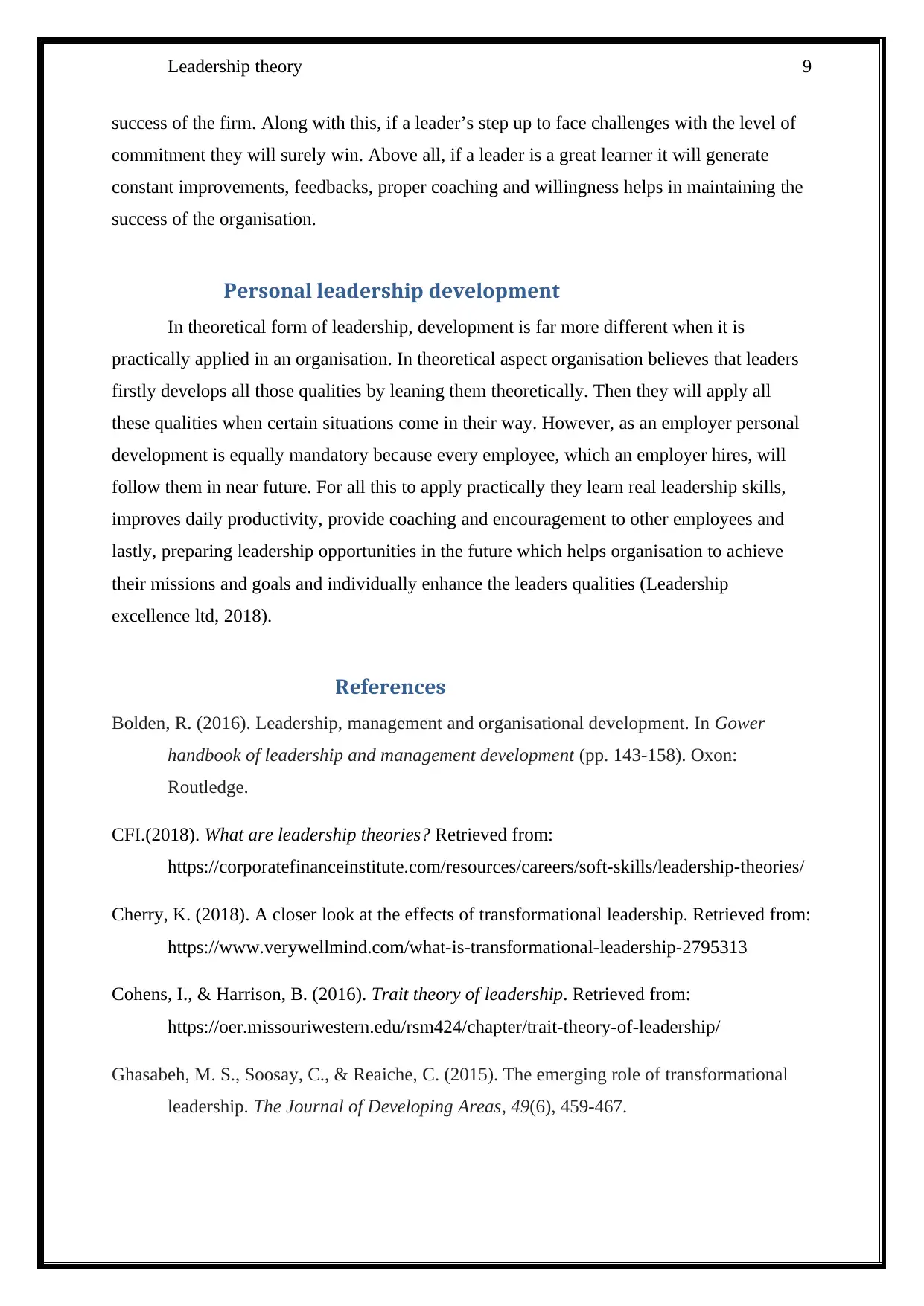
Leadership theory 9
success of the firm. Along with this, if a leader’s step up to face challenges with the level of
commitment they will surely win. Above all, if a leader is a great learner it will generate
constant improvements, feedbacks, proper coaching and willingness helps in maintaining the
success of the organisation.
Personal leadership development
In theoretical form of leadership, development is far more different when it is
practically applied in an organisation. In theoretical aspect organisation believes that leaders
firstly develops all those qualities by leaning them theoretically. Then they will apply all
these qualities when certain situations come in their way. However, as an employer personal
development is equally mandatory because every employee, which an employer hires, will
follow them in near future. For all this to apply practically they learn real leadership skills,
improves daily productivity, provide coaching and encouragement to other employees and
lastly, preparing leadership opportunities in the future which helps organisation to achieve
their missions and goals and individually enhance the leaders qualities (Leadership
excellence ltd, 2018).
References
Bolden, R. (2016). Leadership, management and organisational development. In Gower
handbook of leadership and management development (pp. 143-158). Oxon:
Routledge.
CFI.(2018). What are leadership theories? Retrieved from:
https://corporatefinanceinstitute.com/resources/careers/soft-skills/leadership-theories/
Cherry, K. (2018). A closer look at the effects of transformational leadership. Retrieved from:
https://www.verywellmind.com/what-is-transformational-leadership-2795313
Cohens, I., & Harrison, B. (2016). Trait theory of leadership. Retrieved from:
https://oer.missouriwestern.edu/rsm424/chapter/trait-theory-of-leadership/
Ghasabeh, M. S., Soosay, C., & Reaiche, C. (2015). The emerging role of transformational
leadership. The Journal of Developing Areas, 49(6), 459-467.
success of the firm. Along with this, if a leader’s step up to face challenges with the level of
commitment they will surely win. Above all, if a leader is a great learner it will generate
constant improvements, feedbacks, proper coaching and willingness helps in maintaining the
success of the organisation.
Personal leadership development
In theoretical form of leadership, development is far more different when it is
practically applied in an organisation. In theoretical aspect organisation believes that leaders
firstly develops all those qualities by leaning them theoretically. Then they will apply all
these qualities when certain situations come in their way. However, as an employer personal
development is equally mandatory because every employee, which an employer hires, will
follow them in near future. For all this to apply practically they learn real leadership skills,
improves daily productivity, provide coaching and encouragement to other employees and
lastly, preparing leadership opportunities in the future which helps organisation to achieve
their missions and goals and individually enhance the leaders qualities (Leadership
excellence ltd, 2018).
References
Bolden, R. (2016). Leadership, management and organisational development. In Gower
handbook of leadership and management development (pp. 143-158). Oxon:
Routledge.
CFI.(2018). What are leadership theories? Retrieved from:
https://corporatefinanceinstitute.com/resources/careers/soft-skills/leadership-theories/
Cherry, K. (2018). A closer look at the effects of transformational leadership. Retrieved from:
https://www.verywellmind.com/what-is-transformational-leadership-2795313
Cohens, I., & Harrison, B. (2016). Trait theory of leadership. Retrieved from:
https://oer.missouriwestern.edu/rsm424/chapter/trait-theory-of-leadership/
Ghasabeh, M. S., Soosay, C., & Reaiche, C. (2015). The emerging role of transformational
leadership. The Journal of Developing Areas, 49(6), 459-467.
Paraphrase This Document
Need a fresh take? Get an instant paraphrase of this document with our AI Paraphraser
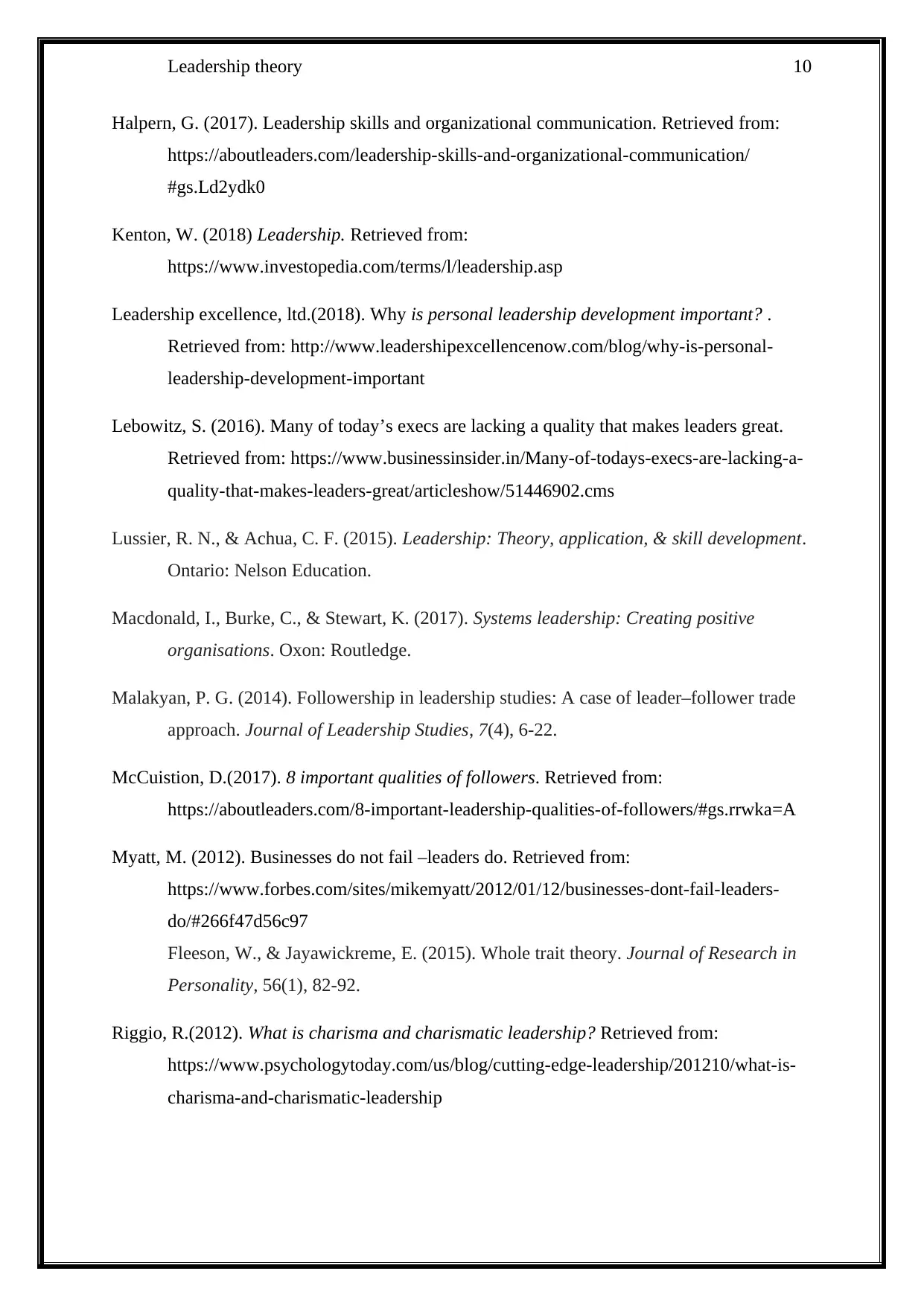
Leadership theory 10
Halpern, G. (2017). Leadership skills and organizational communication. Retrieved from:
https://aboutleaders.com/leadership-skills-and-organizational-communication/
#gs.Ld2ydk0
Kenton, W. (2018) Leadership. Retrieved from:
https://www.investopedia.com/terms/l/leadership.asp
Leadership excellence, ltd.(2018). Why is personal leadership development important? .
Retrieved from: http://www.leadershipexcellencenow.com/blog/why-is-personal-
leadership-development-important
Lebowitz, S. (2016). Many of today’s execs are lacking a quality that makes leaders great.
Retrieved from: https://www.businessinsider.in/Many-of-todays-execs-are-lacking-a-
quality-that-makes-leaders-great/articleshow/51446902.cms
Lussier, R. N., & Achua, C. F. (2015). Leadership: Theory, application, & skill development.
Ontario: Nelson Education.
Macdonald, I., Burke, C., & Stewart, K. (2017). Systems leadership: Creating positive
organisations. Oxon: Routledge.
Malakyan, P. G. (2014). Followership in leadership studies: A case of leader–follower trade
approach. Journal of Leadership Studies, 7(4), 6-22.
McCuistion, D.(2017). 8 important qualities of followers. Retrieved from:
https://aboutleaders.com/8-important-leadership-qualities-of-followers/#gs.rrwka=A
Myatt, M. (2012). Businesses do not fail –leaders do. Retrieved from:
https://www.forbes.com/sites/mikemyatt/2012/01/12/businesses-dont-fail-leaders-
do/#266f47d56c97
Fleeson, W., & Jayawickreme, E. (2015). Whole trait theory. Journal of Research in
Personality, 56(1), 82-92.
Riggio, R.(2012). What is charisma and charismatic leadership? Retrieved from:
https://www.psychologytoday.com/us/blog/cutting-edge-leadership/201210/what-is-
charisma-and-charismatic-leadership
Halpern, G. (2017). Leadership skills and organizational communication. Retrieved from:
https://aboutleaders.com/leadership-skills-and-organizational-communication/
#gs.Ld2ydk0
Kenton, W. (2018) Leadership. Retrieved from:
https://www.investopedia.com/terms/l/leadership.asp
Leadership excellence, ltd.(2018). Why is personal leadership development important? .
Retrieved from: http://www.leadershipexcellencenow.com/blog/why-is-personal-
leadership-development-important
Lebowitz, S. (2016). Many of today’s execs are lacking a quality that makes leaders great.
Retrieved from: https://www.businessinsider.in/Many-of-todays-execs-are-lacking-a-
quality-that-makes-leaders-great/articleshow/51446902.cms
Lussier, R. N., & Achua, C. F. (2015). Leadership: Theory, application, & skill development.
Ontario: Nelson Education.
Macdonald, I., Burke, C., & Stewart, K. (2017). Systems leadership: Creating positive
organisations. Oxon: Routledge.
Malakyan, P. G. (2014). Followership in leadership studies: A case of leader–follower trade
approach. Journal of Leadership Studies, 7(4), 6-22.
McCuistion, D.(2017). 8 important qualities of followers. Retrieved from:
https://aboutleaders.com/8-important-leadership-qualities-of-followers/#gs.rrwka=A
Myatt, M. (2012). Businesses do not fail –leaders do. Retrieved from:
https://www.forbes.com/sites/mikemyatt/2012/01/12/businesses-dont-fail-leaders-
do/#266f47d56c97
Fleeson, W., & Jayawickreme, E. (2015). Whole trait theory. Journal of Research in
Personality, 56(1), 82-92.
Riggio, R.(2012). What is charisma and charismatic leadership? Retrieved from:
https://www.psychologytoday.com/us/blog/cutting-edge-leadership/201210/what-is-
charisma-and-charismatic-leadership
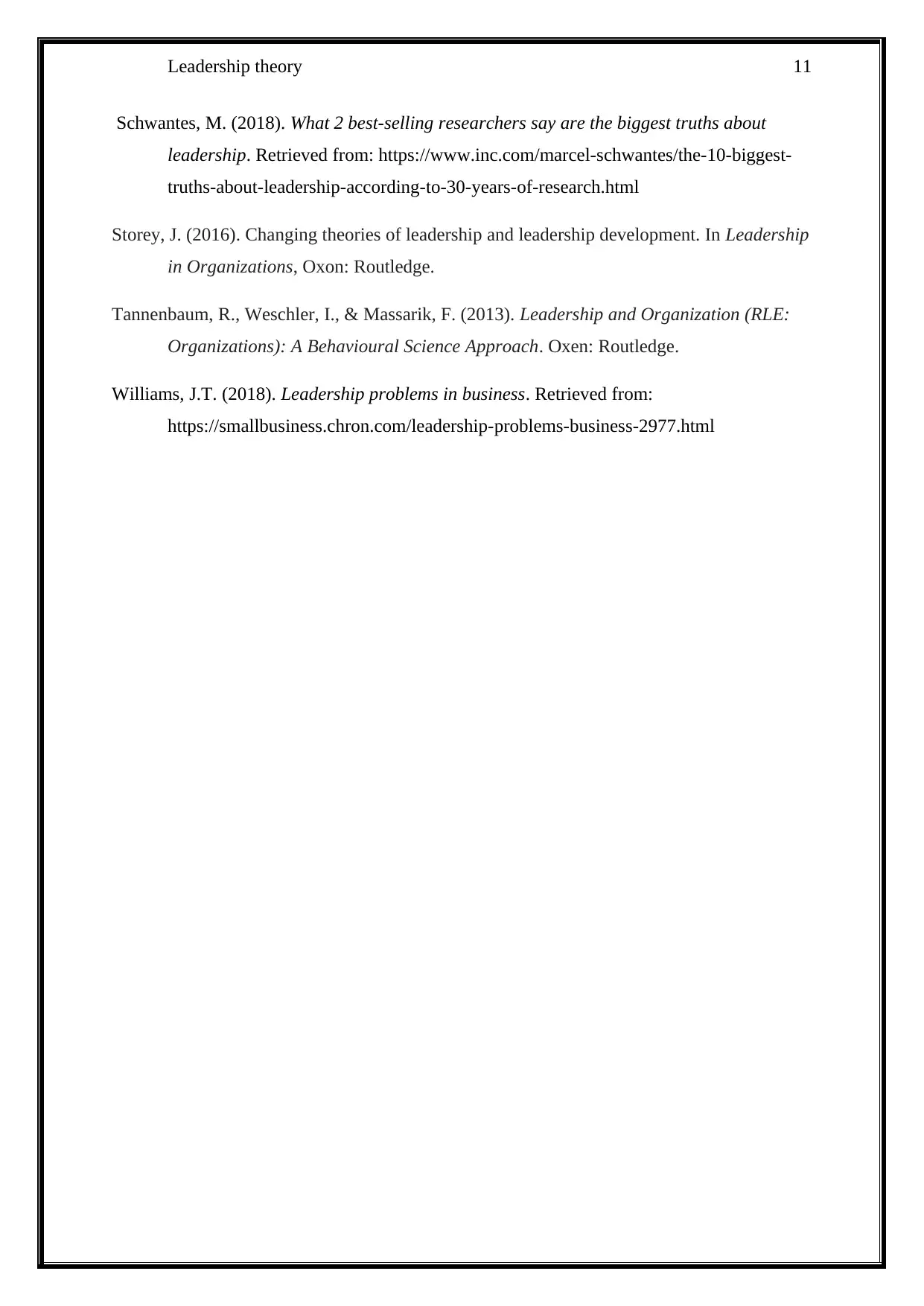
Leadership theory 11
Schwantes, M. (2018). What 2 best-selling researchers say are the biggest truths about
leadership. Retrieved from: https://www.inc.com/marcel-schwantes/the-10-biggest-
truths-about-leadership-according-to-30-years-of-research.html
Storey, J. (2016). Changing theories of leadership and leadership development. In Leadership
in Organizations, Oxon: Routledge.
Tannenbaum, R., Weschler, I., & Massarik, F. (2013). Leadership and Organization (RLE:
Organizations): A Behavioural Science Approach. Oxen: Routledge.
Williams, J.T. (2018). Leadership problems in business. Retrieved from:
https://smallbusiness.chron.com/leadership-problems-business-2977.html
Schwantes, M. (2018). What 2 best-selling researchers say are the biggest truths about
leadership. Retrieved from: https://www.inc.com/marcel-schwantes/the-10-biggest-
truths-about-leadership-according-to-30-years-of-research.html
Storey, J. (2016). Changing theories of leadership and leadership development. In Leadership
in Organizations, Oxon: Routledge.
Tannenbaum, R., Weschler, I., & Massarik, F. (2013). Leadership and Organization (RLE:
Organizations): A Behavioural Science Approach. Oxen: Routledge.
Williams, J.T. (2018). Leadership problems in business. Retrieved from:
https://smallbusiness.chron.com/leadership-problems-business-2977.html
⊘ This is a preview!⊘
Do you want full access?
Subscribe today to unlock all pages.

Trusted by 1+ million students worldwide
1 out of 12
Related Documents
Your All-in-One AI-Powered Toolkit for Academic Success.
+13062052269
info@desklib.com
Available 24*7 on WhatsApp / Email
![[object Object]](/_next/static/media/star-bottom.7253800d.svg)
Unlock your academic potential
Copyright © 2020–2025 A2Z Services. All Rights Reserved. Developed and managed by ZUCOL.





